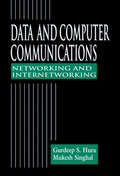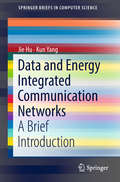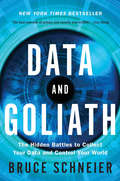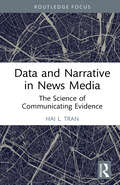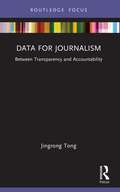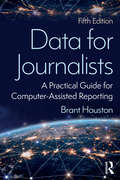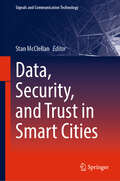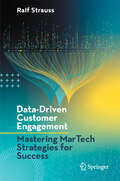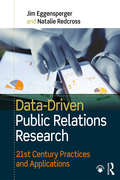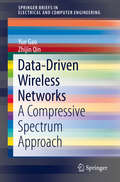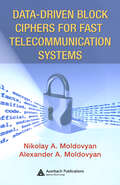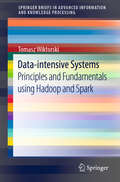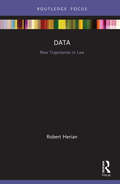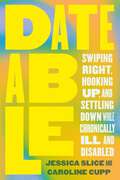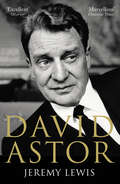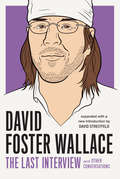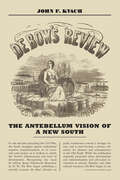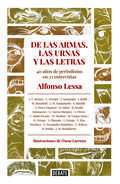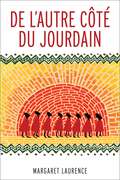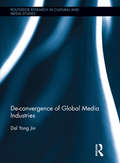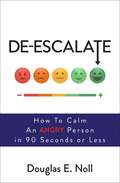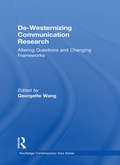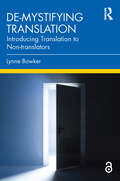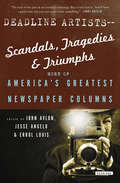- Table View
- List View
Data and Computer Communications: Networking and Internetworking
by Gurdeep S. Hura Mukesh SinghalThe protocols and standards for networking are numerous and complex. Multivendor internetworking, crucial to present day users, requires a grasp of these protocols and standards. Data and Computer Communications: Networking and Internetworking, a comprehensive text/reference, brings clarity to all of the complex issues involved in networking activi
Data and Energy Integrated Communication Networks: A Brief Introduction (SpringerBriefs in Computer Science)
by Kun Yang Jie HuThe book discusses data and energy integrated communication networking technologies, including the latest research contributions in this promising area. It firstly provides an overview of data and energy integrated communication networks (DEINs) and introduces the key techniques for enabling integrated wireless energy transfer (WET) and wireless information transfer (WIT) in the radio frequency (RF) band. It then describes the ubiquitous architecture of DEINs and demonstrates the typical DEIN system and investigates the core issues in both the physical layer and the medium-access-control (MAC) layer in order to coordinate both the WIT and WET in the same RF band. Lastly, the book addresses a number of emerging research topics in the field of DEINs. It promotes joint efforts from both academia and industry to push DEIN a step closer to practical implementation. It is also a valuable resource for students interested in studying cutting-edge techniques in this field.
Data and Goliath: The Hidden Battles to Collect Your Data and Control Your World
by Bruce SchneierYou are under surveillance right now. Your cell phone provider tracks your location and knows who's with you. Your online and in-store purchasing patterns are recorded, and reveal if you're unemployed, sick, or pregnant. Your e-mails and texts expose your intimate and casual friends. Google knows what you're thinking because it saves your private searches. Facebook can determine your sexual orientation without you ever mentioning it. The powers that surveil us do more than simply store this information. Corporations use surveillance to manipulate not only the news articles and advertisements we each see, but also the prices we're offered. Governments use surveillance to discriminate, censor, chill free speech, and put people in danger worldwide. And both sides share this information with each other or, even worse, lose it to cybercriminals in huge data breaches. Much of this is voluntary: we cooperate with corporate surveillance because it promises us convenience, and we submit to government surveillance because it promises us protection. The result is a mass surveillance society of our own making. But have we given up more than we've gained? In Data and Goliath, security expert Bruce Schneier offers another path, one that values both security and privacy. He shows us exactly what we can do to reform our government surveillance programs and shake up surveillance-based business models, while also providing tips for you to protect your privacy every day. You'll never look at your phone, your computer, your credit cards, or even your car in the same way again.
Data and Narrative in News Media: The Science of Communicating Evidence (Routledge Focus on Journalism Studies)
by Hai L. TranBringing together research from across media and psychology disciplines, this book provides an understanding of the impact of using qualitative and quantitative forms of evidence in the news.Drawing on previous studies with seemingly contradictory conclusions, the author proposes an integrative framework that explains the differential roles of data and narrative in evidence-based communication, as well as the potential for their combination. Bridging theory and practice, this book delves into the specific conditions and key factors influencing information processing, combining interdisciplinary scholarship from fields of media effects, persuasion, and cognitive psychology. It emphasizes the importance of incorporating numerical and story elements into journalism through scientific methods, underlining the effects on audience responses according to cognitive-experiential theory. Written accessibly and weaving in contemporary examples and data from around the world, this book expands our understanding of why certain qualitative and quantitative forms of evidence turn out to be (in)effective, translating these findings into take-away lessons to inform more thoughtful news writing and production.Data and Narrative in News Media is a versatile resource for researchers and scholars with an interest in media effects and the presentation of news.
Data for Journalism: Between Transparency and Accountability (Disruptions)
by Jingrong TongConsidering the interactions between developments in open data and data journalism, Data for Journalism: Between Transparency and Accountability offers an interdisciplinary account of this complex and uncertain relationship in a context of tightening the control over data and weighing transparency against privacy. As data has brought both promise and disruptive changes to societies, the relationship between transparency and accountability has become complicated, and data journalism is practised alongside the contradictory needs of opening up and protecting data. In addition to exploring the benefits of data for journalism, this book addresses the uncertain nature of data and the obstacles preventing data from being fluently accessed and properly used for data reporting. Because of these obstacles, it argues individual data journalists play a decisive role in using data for journalism and facilitating the circulation of data. Frictions in data access, newsrooms’ resources and cultures and data journalists’ skill and data literacy levels determine the degree to which journalism can benefit from data, and these factors potentially exacerbate digital inequalities between newsrooms in different countries and with different resources. As such, the author takes an international perspective, drawing on empirical research and cases from around the world, including countries such as the UK, the US, Germany, Sweden, Australia, India, China and Japan. Introducing a new dimension to the study of developments in journalism and the role of journalism in society, Data for Journalism will be of interest to academics and researchers in the fields of journalism and the sociology of (big and open) data.
Data for Journalists: A Practical Guide for Computer-Assisted Reporting
by Brant HoustonThis straightforward and effective how-to guide provides the basics for any reporter or journalism student beginning to use data for news stories. It has step-by-step instructions on how to do basic data analysis in journalism while addressing why these digital tools should be an integral part of reporting in the 21st century. In an ideal core text for courses on data-driven journalism or computer-assisted reporting, Houston emphasizes that journalists are accountable for the accuracy and relevance of the data they acquire and share. With a refreshed design, this updated new edition includes expanded coverage on social media, scraping data from the web, and text-mining, and provides journalists with the tips and tools they need for working with data.
Data, Security, and Trust in Smart Cities (Signals and Communication Technology)
by Stan McClellanThis book provides a comprehensive perspective on issues related to the trustworthiness of information in the emerging “Smart City.” Interrelated topics associated with the veracity of information are presented and discussed by authors with authoritative perspectives from multiple fields. The focus on security, veracity, and trustworthiness of information, data, societal structure and related topics in connected cities is timely, important, and uniquely presented. The authors cover issues related to the proliferation of disinformation and the mechanics of trust in modern society. Topical issues include trust in technologies, such as the use of machine learning (ML) and artificial intelligence (AI), the importance of encryption and cybersecurity, and the value of protecting of critical infrastructure. Structural issues include legal and governmental institutions, including the basis and importance of these fundamental components of society. Functional issues also include issues of societal trust related to healthcare, medical practitioners, and the dependence on reliability of scientific results. Insightful background on the development of AI is provided, and the use of this compelling technology in applications spanning networks, supply chains, and business practices are discussed by practitioners with direct knowledge and convincing perspective. These thought-provoking opinions from notable industry, academia, medicine, law, and government leaders provide substantial benefit for a variety of stakeholders.
Data-Driven Customer Engagement: Mastering MarTech Strategies for Success
by Ralf StraussEmbark on a journey through the rapidly evolving landscape of Marketing Technology (MarTech) with this comprehensive guide. From understanding the strategic imperatives driving MarTech adoption to navigating the intricacies of data-driven customer interaction, this book provides invaluable insights and practical strategies. Explore topics ranging from budget allocation and market potential to data readiness and GDPR compliance, gaining a deep understanding of key concepts and best practices. Whether you're grappling with the complexities of AI integration or seeking to optimize measurement and KPIs, this book equips you with the knowledge and tools needed to thrive in today's digital marketing environment. With decades of industry experience, Ralf Strauss offers in this book a roadmap for success, empowering marketers to navigate the challenges and seize the opportunities presented by MarTech innovation.
Data-Driven Public Relations Research: 21st Century Practices and Applications
by Jim Eggensperger Natalie RedcrossThe public relations industry is undergoing a revolution in using data to define promotional programs, to measure influence and to address the needs of clients with more precision than ever. Applying tools that range from online surveys to social-media listening to applying big data with sophisticated algorithms, today’s PR professionals are data-driven in virtually everything they do. Data-Driven Public Relations Research is the first book for PR students and practitioners to offer an overview of these new practices as well as a glimpse into the future of these new applications, including "big data" and some of the applications from real-world PR campaigns and strategic planning. It includes contemporary cases involving brand name companies who are blazing new trails in the use of metrics in public relations. This book presents a practical, accessible approach that requires no prior training or experience, with easy to follow, step-by-step measurement examples from existing campaigns. Using Excel, the book enables readers to export lessons from the classroom to the office, where use of statistical packages is rare and can give PR practitioners the advantage over competitors. This pragmatic approach helps readers apply metrics to PR problems such as: Finding the best target audiences Understanding audience communication needs and preferences How best to present research outcomes How to manage major projects with specialized research firms. Accompanying electronic resources for the book include sample answers to the book’s discussion questions, PowerPoint lecture slides for instructors and sample research exercises using Excel.
Data-Driven Wireless Networks: A Compressive Spectrum Approach (SpringerBriefs in Electrical and Computer Engineering)
by Yue Gao Zhijin QinThis SpringerBrief discusses the applications of spare representation in wireless communications, with a particular focus on the most recent developed compressive sensing (CS) enabled approaches. With the help of sparsity property, sub-Nyquist sampling can be achieved in wideband cognitive radio networks by adopting compressive sensing, which is illustrated in this brief, and it starts with a comprehensive overview of compressive sensing principles. Subsequently, the authors present a complete framework for data-driven compressive spectrum sensing in cognitive radio networks, which guarantees robustness, low-complexity, and security. Particularly, robust compressive spectrum sensing, low-complexity compressive spectrum sensing, and secure compressive sensing based malicious user detection are proposed to address the various issues in wideband cognitive radio networks. Correspondingly, the real-world signals and data collected by experiments carried out during TV white space pilot trial enables data-driven compressive spectrum sensing. The collected data are analysed and used to verify our designs and provide significant insights on the potential of applying compressive sensing to wideband spectrum sensing. This SpringerBrief provides readers a clear picture on how to exploit the compressive sensing to process wireless signals in wideband cognitive radio networks. Students, professors, researchers, scientists, practitioners, and engineers working in the fields of compressive sensing in wireless communications will find this SpringerBrief very useful as a short reference or study guide book. Industry managers, and government research agency employees also working in the fields of compressive sensing in wireless communications will find this SpringerBrief useful as well.
Data-driven Block Ciphers for Fast Telecommunication Systems
by Nikolai Moldovyan Alexander A. MoldovyanThe Most Progressive and Complete Guide to DDO-Based CiphersDevelopers have long recognized that ciphers based on Permutation Networks (PNs) and Controlled Substitution-Permutation Networks (CSPNs) allow for the implementation of a variety of Data Driven Operations (DDOs). These DDOs can provide fast encryption without incurring excessive
Data-intensive Systems: Principles And Fundamentals Using Hadoop And Spark (Advanced Information and Knowledge Processing)
by Tomasz WiktorskiData-intensive systems are a technological building block supporting Big Data and Data Science applications.This book familiarizes readers with core concepts that they should be aware of before continuing with independent work and the more advanced technical reference literature that dominates the current landscape. The material in the book is structured following a problem-based approach. This means that the content in the chapters is focused on developing solutions to simplified, but still realistic problems using data-intensive technologies and approaches. The reader follows one reference scenario through the whole book, that uses an open Apache dataset. The origins of this volume are in lectures from a master’s course in Data-intensive Systems, given at the University of Stavanger. Some chapters were also a base for guest lectures at Purdue University and Lodz University of Technology.
Data: New Trajectories in Law (New Trajectories in Law)
by Robert HerianThis book explores the phenomenon of data – big and small – in the contemporary digital, informatic and legal-bureaucratic context. Challenging the way in which legal interest in data has focused on rights and privacy concerns, this book examines the contestable, multivocal and multifaceted figure of the contemporary data subject. The book analyses "data" and "personal data" as contemporary phenomena, addressing the data realms, such as stores, institutions, systems and networks, out of which they emerge. It interrogates the role of law, regulation and governance in structuring both formal and informal definitions of the data subject, and disciplining data subjects through compliance with normative standards of conduct. Focusing on the ‘personal’ in and of data, the book pursues a re-evaluation of the nature, role and place of the data subject qua legal subject in on and offline societies: one that does not begin and end with the inviolability of individual rights but returns to more fundamental legal principles suited to considerations of personhood, such as stewardship, trust, property and contract. The book’s concern with the production, use, abuse and alienation of personal data within the context of contemporary communicative capitalism will appeal to scholars and students of law, science and technology studies, and sociology; as well as those with broader political interests in this area.
Dateable: Swiping Right, Hooking Up, and Settling Down While Chronically Ill and Disabled
by Jessica Slice Caroline CuppA much-needed guide for disabled and chronically ill people to dating - from apps to hooking up, sex, and more - from disabled essayist and author Jessica Slice and bioethicist Caroline Cupp. Disabled people date, have casual sex, marry, and parent. Yet our romantic lives are conspicuously absent from the media and cultural conversation. Sexual education does not typically address the specific information needed by disabled students. Mainstream dating apps fail to include disability as an aspect of one&’s identity alongside race, ethnicity, gender identity, and sexual orientation. The few underutilized disability-focused apps are paternalistic and unappealing. Bestselling dating books do not address disability, and the few relationship books marketed to disabled people focus on the mechanics of sex rather than the complex interactions that create the conditions for it. In Dateable, disabled authors Jessica Slice Caroline Cupp team up to address the serious gap in the dating space. Dateable is the first book on disabled dating and relationships; it&’s a dating guide made especially for disabled and chronically ill people, that also calls in nondisabled readers. Jessica and Caroline take on everything from rom-com representation and dating apps to sex and breakups with a strong narrative underpinning and down-to-earth advice. The book is as much a practical tool as it is an empowering guide.
David Astor
by Jeremy LewisFew newspaper editors are remembered beyond their lifetimes, but David Astor of the Observer is a great exception to the rule. He converted a staid, Conservative-supporting Sunday paper into essential reading, admired and envied for the quality of its writers and for its trenchant but fair-minded views. Astor grew up at Cliveden, the country house on the Thames which his grandfather had bought when he turned his back on New York, the source of the family fortune. His liberal-minded father was a constant support, but his relations with his mother, Nancy, were always embattled. At Oxford he suffered the first of the bouts of depression that were to blight his life; a lost soul for much of the Thirties, he became involved in attempts to put the British Government in touch with the German opposition in the months leading up to the war. George Orwell had urged Astor to champion the decolonisation of Africa, and Nelson Mandela always acknowledged how much he owed to the Observer’s long-standing support. A generous benefactor to good causes, he helped to set up Amnesty International and Index on Censorship. A good man and a great editor, he deserves to be better remembered.
David Foster Wallace: and Other Conversations (The Last Interview Series)
by David Foster Wallace David StreitfeldAn expanded edition featuring new interviews and an introduction by the editor, a New York Times journalist and friend of the authorA unique selection of the best interviews given by David Foster Wallace, including the last he gave before his suicide in 2008. Complete with an introduction by Foster Wallace's friend and NY Times journalist, David Streitfeld. And including a new, never-before-published interview between Streitfeld and Wallace.
De Bow's Review: The Antebellum Vision of a New South (New Directions In Southern History Ser.)
by John F. KvachA study of the nineteenth-century magazine from the American South, its editor, and influence on the region.In the decades preceding the Civil War, the South struggled against widespread negative characterizations of its economy and society as it worked to match the North’s infrastructure and level of development. Recognizing the need for regional reform, James Dunwoody Brownson (J. D. B.) De Bow began to publish a monthly journal?De Bow’s Review?to guide Southerners toward a stronger, more diversified future. His periodical soon became a primary reference for planters and entrepreneurs in the Old South, promoting urban development and industrialization and advocating investment in schools, libraries, and other cultural resources. Later, however, De Bow began to use his journal to manipulate his readers’ political views. Through inflammatory articles, he defended proslavery ideology, encouraged Southern nationalism, and promoted anti-Union sentiment, eventually becoming one of the South’s most notorious fire-eaters.In De Bow’s Review: The Antebellum Vision of a New South, author John Kvach explores how the editor’s antebellum economic and social policies influenced Southern readers and created the framework for a postwar New South movement. By recreating subscription lists and examining the lives and livelihoods of 1,500 Review readers, Kvach demonstrates how De Bow’s Review influenced a generation and a half of Southerners. This approach allows modern readers to understand the historical context of De Bow’s editorial legacy. Ultimately, De Bow and his antebellum subscribers altered the future of their region by creating the vision of a New South long before the Civil War.“Kvach fills a surprising gap in the history of the nineteenth-century South with this elegantly written biography of the enigmatic J. D. B. De Bow. The work represents an important contribution to a growing historiography exploring the presence of a middle-class commercial culture in the pre–Civil War South and challenging long-held views of a static socioeconomic world of planters and plain folk.” —Bruce W. Eelman, author of Entrepreneurs in the Southern Upcountry: Commercial Culture in Spartanburg, South Carolina, 1845-1880“An insightful, original, deeply researched work of scholarship. Examining not only the career of journalist J. D. B. De Bow but also the readers who responded enthusiastically to his call for economic diversification, John F. Kvach helps us see the nineteenth-century South in a new way, undistorted by the stark, artificial line so many historians have drawn to separate the so-called Old South from the New.” —Stephen V. Ash, author of A Massacre in Memphis: The Race Riot That Shook the Nation One Year after the Civil War“DeBow was the antebellum South’s most prominent advocate of economic modernization and industrialization, and one of its most vitriolic secessionists. John Kvach explores this seeming paradox, and gives us as well a careful description of DeBow’s subscribers and followers.” —J. Mills Thornton, University of Michigan
De las armas, las urnas y las letras: 40 años de periodismo en 23 entrevistas
by Alfonso LessaUn libro que recupera la tradición de la entrevista en profundidad, de la mano de Alfonso Lessa, periodista de amplia y reconocida trayectoria en nuestro país. Con ilustraciones de Óscar Larroca. La entrevista es un género que nos permite asomarnos a la intimidad de personalidades destacadas de un modo profundo y particular, para percibir aquello que no siempre está en la superficie. Cuando el trabajo del periodista es eficaz, los lectores participamos de un relato que ilumina a la persona real que se oculta detrás del personaje. En este libro, Alfonso Lessa nos invita a un recorrido por cuarenta años de labor periodística, durante el cual coincidió con personajes clave del quehacer político y cultural, en momentos significativos de su trayectoria y en una particular coyuntura histórica. Un paseo en Mehari por el barrio del Prado con Jorge Luis Borges, el encuentro con Raúl Sendic en la casa de su hermano, o una conversación íntima con un Mario Benedetti que se reencontraba con el Uruguay luego de un largo exilio, son algunas de las pinturas que componen este libro, y que describen al «hombre y su circunstancia», revelando más de lo que se percibe en la superficie. El libro se completa con admirables ilustraciones de Óscar Larroca, que abordan a los personajes desde una nueva perspectiva y completan un libro imprescindible, que recupera el valor de la entrevista periodística. Cuando Alfonso Lessa se despedía del semanario Aquí en 1987, su editorial destacaba: «Siempre estaba atrás de las notas más polémicas, buscando la palabra de las fuentes más vedadas, recogiendo los datos más secretos (#) Alfonso Lessa es un claro representante de esta generación nueva de periodistas, formada en tiempos de dictadura y forjada en el espíritu de lucha y sacrificio».
De l’autre côté du Jourdain (Traduction littéraire)
by Margaret LaurenceGhana, 1956. Nous sommes à la veille de l’indépendance. Nathaniel Amegbe est professeur dans une école ghanéenne plutôt médiocre. Johnnie Kestoe est comptable dans une firme textile britannique à Accra. Les deux hommes s’affronteront autour de la question de l’« africanisation », cette politique de passation des responsabilités entre Britanniques et Ghanéens. De l’autre côté du Jourdain est le premier roman de Margaret Laurence, cette matriarche de la littérature. Cette traduction est une invitation à découvrir une facette méconnue de l’œuvre d’une grande écrivaine qui, pendant son séjour en Afrique de 1950 à 1956, a su capter tout l’espoir et les bouleversements imposés par les indépendances africaines à l’ordre du monde. Mais avant tout, il s’agit d’une invitation à découvrir une Afrique fébrile, des personnages attachants, le tout écrit avec un talent incontestable, dans une pluralité de voix à couper le souffle. Réflexion sur l’indépendance, tant intérieure que politique, De l’autre côté du Jourdain annonçait déjà les grands romans emblématiques de Laurence, dont, L’ange de pierre et Les devins. Publié en français
De-Convergence of Global Media Industries: De-convergence Of Global Media Industries (Routledge Research in Cultural and Media Studies #47)
by Dal Yong JinConvergence has become a buzzword, referring on the one hand to the integration between computers, television, and mobile devices or between print, broadcast, and online media and on the other hand, the ownership of multiple content or distribution channels in media and communications. Yet while convergence among communications companies has been the major trend in the neoliberal era, the splintering of companies, de-convergence, is now gaining momentum in the communications market. As the first comprehensive attempt to analyze the wave of de-convergence of the global media system in the context of globalization, this book makes sense of those transitions by looking at global trends and how global media firms have changed and developed their business paradigm from convergence to de-convergence. Jin traces the complex relationship between media industries, culture, and globalization by exploring it in a transitional yet contextually grounded framework, employing a political economic analysis integrating empirical data analysis.
De-Escalate: How to Calm an Angry Person in 90 Seconds or Less
by Douglas E. NollDiscover how to successfully and efficiently calm an angry person or diffuse a volatile situation in ninety seconds or less with this proven and accessible peacekeeping method by self-described “lawyer turned peacemaker” Douglas E. Noll.We live in an increasingly divided world and most of us have encountered our fair share of aggressive people and difficult confrontations. Fortunately, we now have the tools to become peacemakers and transform emotionally volatile situations and hurt feelings to calm, non-aggressive ones. Tested on prison inmates, De-Escalate offers a new set of social listening and communication skills, based on the latest findings in neuroscience and meditation. Along with practical exercises and scenario-based examples, each chapter focuses on specific themes, such as dealing with emotionally charged teenagers and frustrated coworkers. Additionally, Noll shares practical tips on how to be civil in an uncivil society. With De-Escalate, we can bring peace to all facets of life, cultivate healthier relationships, and participate in creating a more caring and compassionate future for us all.
De-Westernizing Communication Research: Altering Questions and Changing Frameworks (Routledge Contemporary Asia Series)
by Georgette WangThe rise of postmodern theories and pluralist thinking has paved the way for multicultural approaches to communication studies and now is the time for decentralization, de-Westernization, and differentiation. This trend is reflected in the increasing number of communication journals with a national or regional focus. Alongside this proliferation of research output from outside of the mainstream West, there is a growing discontent with communication theories being “Westerncentric”. Compared with earlier works that questioned the need to distinguish between the Western and the non-Western, and to build “Asian” communication theories, there seems to be greater assertiveness and determination in searching for and developing theoretical frameworks and paradigms that take consideration of, and therefore are more relevant to, the cultural context in which research is accomplished. This path-breaking book moves beyond critiquing “Westerncentrism” in media and communication studies by examining where Eurocentrism has come from, how is it reflected in the study of media and communication, what the barriers and solutions to de-centralizing the production of theories are, and what is called for in order to establish Asian communication theories.
De-mystifying Translation: Introducing Translation to Non-translators
by Lynne BowkerThis textbook provides an accessible introduction to the field of translation for students of other disciplines and readers who are not translators. It provides students outside the translation profession with a greater awareness of, and appreciation for, what goes into translation. Providing readers with tools for their own personal translation-related needs, this book encourages an ethical approach to translation and offers an insight into translation as a possible career. This textbook covers foundational concepts; key figures, groups, and events; tools and resources for non-professional translation tasks; and the types of translation that non-translators are liable to encounter. Each chapter includes practical activities, annotated further reading, and summaries of key points suitable for use in classrooms, online teaching, or self-study. There is also a glossary of key terms. De-mystifying Translation: Introducing Translation to Non-translators is the ideal text for any non-specialist taking a course on translation and for anyone interested in learning more about the field of translation and translation studies.
Deadline
by James RestonThis book contains the memoirs of the New York Times columnist James Reston in which he expresses his opinion about many world-famous leaders.
Deadline Artists—Scandals, Tragedies & Triumphs: More of America's Greatest Newspaper Columns
by Jack London H. L. Mencken Carl Hiaasen Molly Ivins Peggy Noonan Murray Kempton Mitch Albom Richard Wright Steve Lopez Pete Hamill Nicholas Kristof Damon Runyon Leonard Pitts Jr. Dorothy Thompson Shirley Povich Mike Ryoko Ruben Salazar Mary McGrory Mike BarnicleAn anthology of newspaper columns from the 19th century to the present—&“engaging eyewitness pieces [that] elicit admiration, wonder and gasps of surprise&” (Kirkus Reviews). Deadline Artists: America&’s Greatest Newspaper Columns drew together some of the finest examples of America&’s greatest unsung literary form: the newspaper column. In this new Deadline Artists collection, some of America&’s greatest journalists take on the stories of scandal, tragedy, triumph, and tribute that have defined the spirit of their age. This is history written in the present tense, offering high drama and enduring wisdom. Walk with Jack London in the aftermath of the San Francisco earthquake or grieve with Walt Whitman over the assassination of Abraham Lincoln. Watch as Watergate unfolds, sex scandals explode, the Twin Towers collapse, and winning home runs capture the thrill of a comeback capped with a World Series victory. Contributors include: Jack London, H.L. Mencken, Dorothy Thompson, Richard Wright, Damon Runyon, Shirley Povich, Murray Kempton, Mike Ryoko, Ruben Salazar, Mary McGrory, Mike Barnicle, Molly Ivins, Pete Hamill, Carl Hiaasen, Nicholas Kristof, Leonard Pitts, Steve Lopez, Peggy Noonan, and Mitch Albom.
